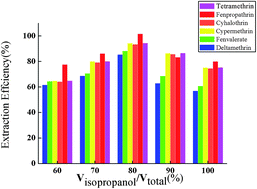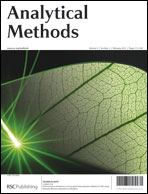A novel method for the analysis of 6 pyrethroids in fish samples, based on the use of a modified QuEChERS (Quick, Easy, Cheap, Effective, Rugged and Safe) approach followed by gas chromatography (GC) method, is reported. In previous reports, it is surprising to find that only acetonitrile was used as the original QuEChERS extraction solvent. In the present work, the QuEChERS method was modified by replacing the traditional acetonitrile with isopropanol. It showed that the use of isopropanol improved the extraction efficiency of the QuEChERS. For the pyrethroids in the protein–matrix samples, the overall recoveries of 75.8–89.4% for the modified QuEChERS method are better than those of 68.9–84.8% for the original QuEChERS method. Fluorescence quenching spectra of BSA with pyrethroids showed that the strong binding interaction between pyrethroids pesticides and protein decreased the extraction efficiency of pyrethroids from fish samples. However, in the 80% (volume fraction) isopropanol aqueous solution, a slow protein denaturation might take place, which would cause the unfolding of protein and the release of pyrethroids. This resulted in the high extraction efficiency of pyrethroids from protein matrix samples. The method was used satisfactorily for the determination of 6 pyrethroid pesticides in spiked fish samples. This paper proposes a new strategy by slowing down the protein denaturation and releasing bound pesticides to enhance the extraction efficiency of pyrethroids in fish samples.

You have access to this article
 Please wait while we load your content...
Something went wrong. Try again?
Please wait while we load your content...
Something went wrong. Try again?


 Please wait while we load your content...
Please wait while we load your content...